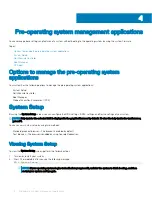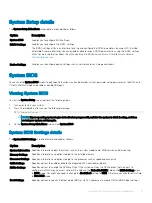
Option
Description
Embedded Video
Controller
Enables or disables the use of Embedded Video Controller as the primary display. When set to
Enabled
, the
Embedded Video Controller will be the primary display even if add-in graphic cards are installed. When set to
Disabled
, an add-in graphics card will be used as the primary display. BIOS will output displays to both the primary
add-in video and the embedded video during POST and pre-boot environment. The embedded video will then be
disabled right before the operating system boots. This option is set to
Enabled
by default.
NOTE:
When there are multiple add-in graphic cards installed in the system, the first card discovered
during PCI enumeration is selected as the primary video. You might have to re-arrange the cards in the
slots in order to control which card is the primary video.
Current State of
Embedded Video
Controller
Displays the current state of the embedded video controller. The
Current State of Embedded Video Controller
option is a read-only field. If the Embedded Video Controller is the only display capability in the system (that is, no
add-in graphics card is installed), then the Embedded Video Controller is automatically used as the primary display
even if the
Embedded Video Controller
setting is set to
Disabled
.
SR-IOV Global
Enable
Enables or disables the BIOS configuration of Single Root I/O Virtualization (SR-IOV) devices. This option is set to
Disabled
by default.
Internal SD Card
Port
Enables or disables the Internal SD Card Port of the Internal Dual SD Module (IDSDM). This option is set to
On
by
default.
Internal SD Card
Redundancy
Configures the redundancy mode of the Internal Dual SD Module (IDSDM). When set to
Mirror
Mode, data is
written on both SD cards. After failure of either card and replacement of the failed card, the data of the active card
is copied to the offline card during the system boot.
When Internal SD Card Redundancy is set to
Disabled
, only the primary SD card is visible to the OS. This option is
set to
Disabled
by default.
Internal SD Primary
Card
When
Redundancy
is set to
Disabled
, either one of the SD card can be selected to present itself as mass storage
device by setting it to be primary card. By default primary SD card is selected to be SD Card 1. If SD Card 1 is not
present, then the controller will select SD Card 2 to be primary SD card.
OS Watchdog
Timer
If your system stops responding, this watchdog timer aids in the recovery of your operating system. When this
option is set to
Enabled
, the operating system initializes the timer. When this option is set to
Disabled
(the
default), the timer does not have any effect on the system.
Memory Mapped
I/O above 4 GB
Enables or disables the support for the PCIe devices that need large amounts of memory. Enable this option only
for 64-bit operating systems. This option is set to
Enabled
by default.
Memory Mapped
I/O Base
When set to
12 TB
, the system will map MMIO base to 12 TB. Enable this option for an OS that requires 44 bit
PCIe addressing. Enable this option only for the 4 GPU DGMA issue. This option is set to
56 TB
by default. When
set to
512 GB
, the system will map MMIO base to 512 GB.
NOTE:
Setting Memory Mapped I/O Base to 512 GB requires less than 512 GB of physical memory else
the system might fail to POST.
Mezzanine Slot
Disablement
The Slot Disablement feature controls the configuration of mezzanine cards installed in the specified slots. Only
mezzanine card slots that are present on your system are available for control.
30
Pre-operating system management applications







































